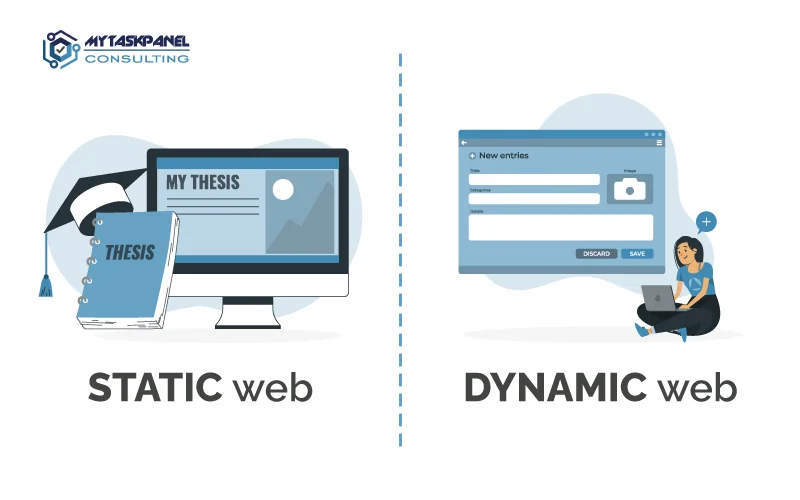Websites are a fundamental part of any company’s online presence. There are two main types of web pages: static and dynamic. In this article, we will tell you what static and dynamic websites are, and what are the benefits and disadvantages of each type.
What is a static web page?
A static website is a type of web page that displays fixed and non-changing information. These pages do not have the ability to interact with users or to change content in real time. Instead, static web pages are created and published with fixed content, which is the same for all users who visit the page.
Static web pages are easy to create and maintain, and are suitable for simple or informational websites that do not require frequent interaction or updates.
Benefits of a static website
- Easy to build and maintain: It does not require advanced technical knowledge or expensive resources to build and maintain.
- Fast Loading: It has a faster load time than dynamic pages, which can improve user experience and SEO.
- Safer: by not having a database or dynamic elements, it is less vulnerable to hacking attacks and other security problems.
- Less expensive: it requires fewer resources and costs than dynamic pages, making it a cheaper option for small businesses or individuals.
- Better for SEO: easier to optimize for search engines, which can improve your ranking in search results.
Drawbacks of a static website
- Lack of interactivity: it can’t interact with users, which means it can’t collect information or serve online forms.
- Fixed content: it is not possible to update it in real time. This means that updates must be done manually and published on the page.
- Shortage of dynamic features: it cannot provide dynamic features, such as live chats, shopping carts, or registration systems.
- Poor scalability: it is suitable for small or informative websites, but cannot handle large amounts of traffic or dynamic data.
- Lack of personalization: it cannot personalize content for each user or offer a personalized experience.
Examples of static websites
Some examples of static web pages include:
- Personal blog sites.
- Professional portfolios.
- Information sites, such as wikis or reference sites.
- Basic corporate sites that display information about the company and its products or services.
- Galleries of images or videos.
- Landing pages of advertising campaigns.
- Landing pages for individual products or services.
What is a dynamic web page?
A dynamic web page is a type of website that generates content in real time based on user interaction. Unlike static web pages, which display the same content to all users, dynamic web pages can be customized and change in real time. This is accomplished by using programming languages, such as PHP, Ruby on Rails, or JavaScript, and connecting to a database.
Dynamic web pages have a large number of interactive features, including contact forms, registration systems, live chats, shopping carts and data collection systems. Plus, they can easily scale to handle large amounts of traffic and dynamic data.
Benefits of a dynamic website
- User interaction: it allows users to interact with the site more effectively, including: filling out forms, making comments and purchases.
- Personalization: it can be personalized in real time, based on user interaction. This increases user satisfaction and the effectiveness of the page.
- Easy updating: easier to update and manage than a static web page. The contents and functions of the site can be updated and improved more frequently and easily.
- Data analytics: it usually has built-in tracking that allows site owners to collect and analyze data about their audience and performance.
- Scalability: it is easier to scale to handle large amounts of traffic and dynamic data.
- Flexibility: it is more flexible than a static web page and can be designed and developed to meet the specific needs of a company.
Drawbacks of a dynamic website
- It needs more resources and powerful hardware.
- It can be more difficult to optimize for search engines.
- It requires a higher cost of development and maintenance.
- It may be more vulnerable to security attacks.
- It can be more difficult for users to interact with the page.
Examples of dynamic websites
- Social networks (Facebook, Twitter, etc.).
- Online stores (Amazon, eBay, etc.).
- News portals (CNN, BBC, etc.).
- Blogging platforms (WordPress, Blogger, etc.).
- Content management systems (Drupal, Joomla, etc.).
In conclusion, static and dynamic websites have their own advantages and disadvantages, and the right choice depends on the needs and objectives of each company or business. Static web pages are suitable for small and simple websites, while dynamic web pages are better for more complex applications and websites that require real-time interaction with the user. When choosing between these options, it’s important to consider factors such as performance, scalability, security, and cost. At MyTaskPanel Consulting, we can help you take the best path for your project.










